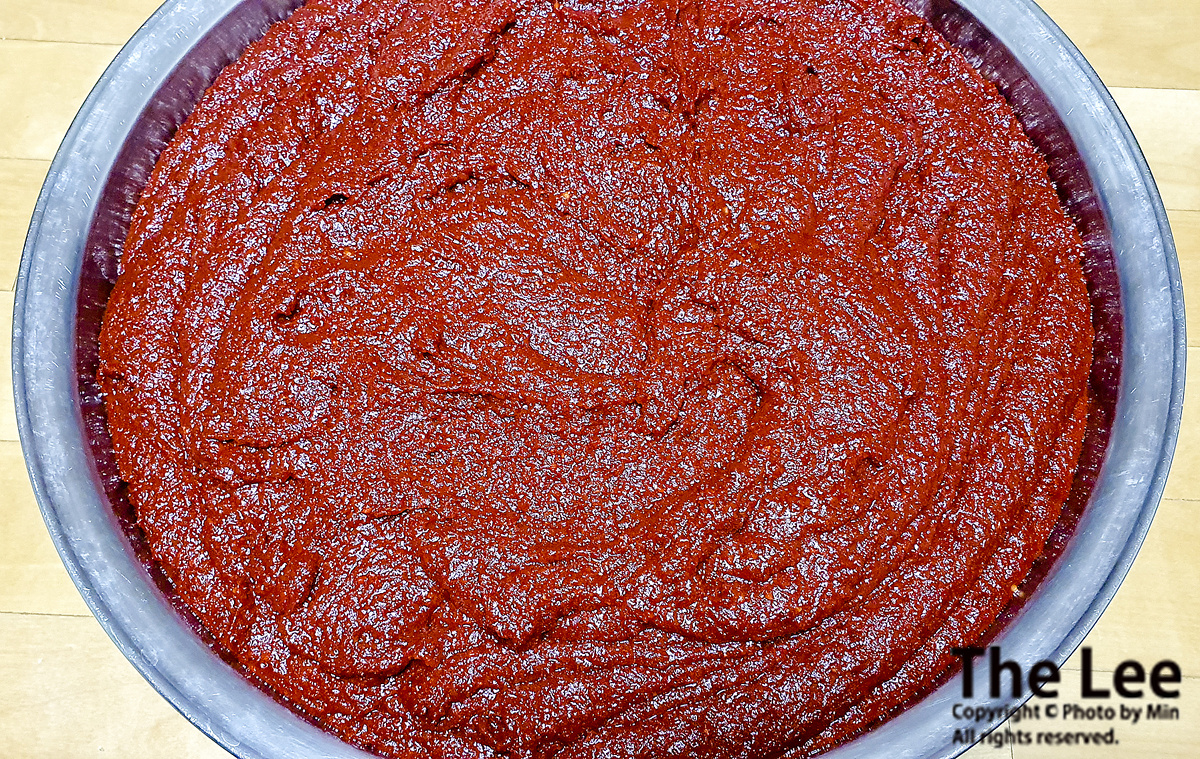Spicy & Sweet Homemade Gochujang
How to Make Delicious Homemade Gochujang (Korean Chili Paste) at Home

This recipe guides you through making a deliciously spicy and sweet homemade Gochujang using chili powder harvested from your own chili plants. Enjoy the fresh, robust flavor of freshly made Gochujang, free from artificial additives.
Ingredients- Sun-dried Sea Salt 3 large bowls (approx. 1kg)
- Water 10 liters
- Malt Barley Powder (Yeot-gireum) 600g
- Fine Chili Powder (Gochugaru) 2kg (adjust to taste)
- Glutinous Barley Flour 1kg
- Rice Syrup (Jocheong) 3kg
- Oligosaccharide 700g
- Fermented Soybean Paste Powder (Meju Powder) 1kg
- Soju (Korean Distilled Liquor) 1 bottle (high proof recommended)
- Gimbap Seaweed Sheets 2 sheets (optional)
Cooking Instructions
Step 1
First, place 3 large bowls of sun-dried sea salt into a heavy-bottomed pot. Stir-fry over medium-low heat to remove moisture. This step helps the salt dissolve better and prevents the growth of unwanted bacteria. Let the roasted salt cool completely.

Step 2
Prepare a large pot and add 6 liters of clean water. Bring it to a rolling boil over high heat. This boiling water will be used to dissolve the malt barley and glutinous barley flour.

Step 3
In a separate large bowl, place 600g of malt barley powder. Pour in some of the 4 liters of boiled water. Whisk or stir thoroughly to dissolve the malt barley powder, ensuring there are no lumps. It’s crucial to get a smooth consistency.

Step 4
Once the malt barley powder is fully dissolved, sift in 1kg of glutinous barley flour. Stir well again to combine and prevent any clumps from forming. Glutinous barley flour will contribute to the smooth texture of the Gochujang.

Step 5
Use a spatula or sieve to ensure the dissolved malt barley and glutinous barley flour mixture is smooth and lump-free. Stir until it reaches a slightly sticky consistency.

Step 6
Now, slowly pour the malt barley and glutinous barley flour mixture into the large pot containing the 6 liters of boiling water. Stir continuously as you pour to prevent lumps from forming.

Step 7
Maintain high heat and stir constantly to prevent the mixture from sticking to the bottom of the pot. After about 30 minutes of stirring, you’ll notice the initially thin liquid start to thicken slightly. However, continue stirring, and it will become thinner again. This process involves reducing the water by about a quarter, extracting the sugars from the malt barley and adjusting the consistency. This is a crucial step for developing flavor and texture.

Step 8
Once the mixture has reduced to the desired consistency, add 3kg of rice syrup (Jocheong). Stir and cook for another 30 minutes. After it’s well combined and warmed through, turn off the heat. Transfer the pot to a cool place, like a balcony, and let it cool completely for at least 1 hour. It’s important to let it cool thoroughly before adding the next ingredients, as hot temperatures can interfere with proper fermentation.

Step 9
Transfer the mixture to a wide stainless steel bowl or container to further cool down. Once completely cooled, add 1kg of meju powder (fermented soybean paste powder). Mix until it’s smoothly incorporated with no lumps. Meju powder adds a savory depth and aids in fermentation.

Step 10
Now, add 2kg of fine chili powder (Gochugaru). Stir meticulously until all the chili powder is evenly distributed and no dry clumps remain. You can adjust the amount of chili powder according to your spice preference.

Step 11
Add 2.5 large bowls of the roasted sea salt prepared earlier. Stir well until the salt is completely dissolved. Salt acts as a preservative and balances the flavor of the Gochujang.

Step 12
Mix in 700g of oligosaccharide to add sweetness and a glossy sheen. Oligosaccharide helps adjust the Gochujang’s consistency and provides a smooth sweetness.

Step 13
Finally, pour in 1 bottle of soju with a high alcohol content. Soju helps prevent the growth of unwanted bacteria and preserves the Gochujang. Stir one last time to ensure all ingredients are thoroughly combined.

Step 14
Allow the Gochujang mixture to cool down completely at room temperature. It’s best to let it cool naturally rather than rushing to transfer it to storage containers.

Step 15
Once the homemade Gochujang has completely cooled, transfer it into your prepared storage container. Kimchi containers are convenient for storing large batches. Ensure the container is clean and completely dry before use.

Step 16
After filling the container, place two sheets of Gimbap seaweed on top of the Gochujang. The seaweed layer helps prevent oxidation by minimizing contact with air, keeping the Gochujang fresh.

Step 17
Cover the seaweed with a clean cloth or muslin. This helps regulate moisture and prevents any foreign particles from entering the container.

Step 18
Seal the container with its lid or cover. Store it in a cool, dark place like a balcony for about 2 weeks to allow the Gochujang to ferment and develop its deep flavors. After the fermentation period, store it in a kimchi refrigerator to maintain its freshness and delicious taste for a long time. Enjoy your delicious homemade spicy and sweet Gochujang!




